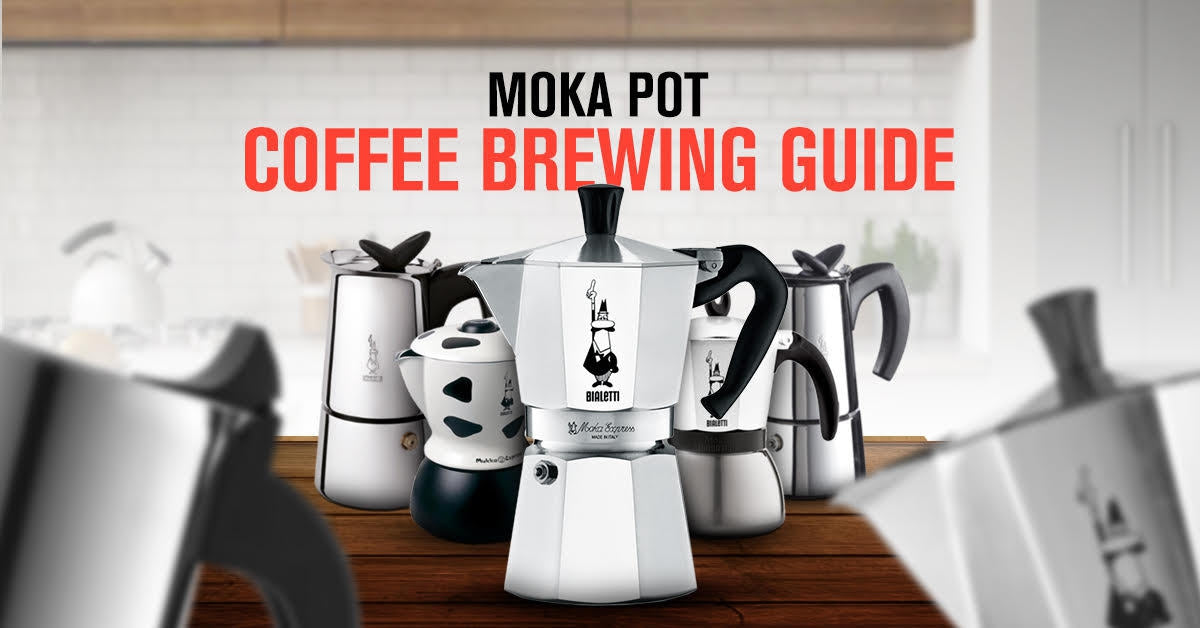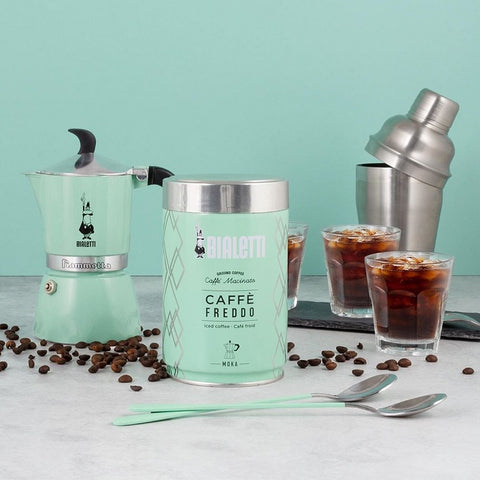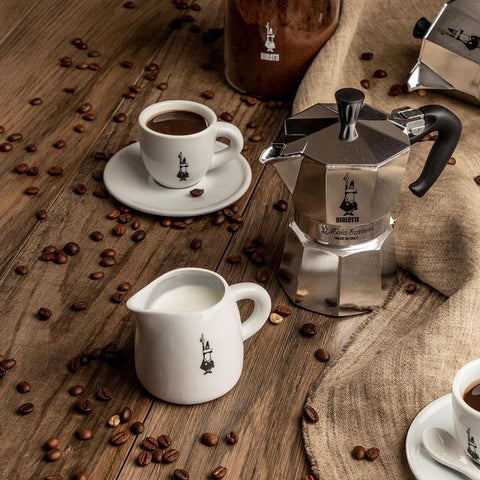
Moka Pot Coffee Brewing Guide
The chances are you’ve heard of moka pots. These little miracles have been considered the best stove coffee maker for nearly a century. Their popularity worldwide means this percolator is one of the most commonly used methods for brewing coffee.
The reason for its immense popularity is really quite simple: a stove top coffee maker can produce great quality espresso style coffee at a fraction of the price.
In post-WW1 Italy, these espresso makers was literally a godsend to impoverished Italian coffee lovers.
Learning how to make stovetop coffee in a pot might change your life a little too. Let’s face it, many of us can’t justify the expense of buying a specialty coffee machine for our home for brewing coffee. With a moka pot, however, you can produce espresso style coffee at home for next to nothing. You just need to know how to use a stove coffee maker. Just keep reading and we’ll tell exactly how to make espresso with moka pot.
What Is A Moka Pot?
 OK, so let’s rewind a little. To the uninitiated, well, it’s a little aluminium pot which you place hot water and coffee inside, place on the stove and voila; coffee. Of course, there’s a lot more to it than that. To properly understand the percolator, how it works, and why it’s so popular, we need to take ourselves back to Mussolini’s Italy.
OK, so let’s rewind a little. To the uninitiated, well, it’s a little aluminium pot which you place hot water and coffee inside, place on the stove and voila; coffee. Of course, there’s a lot more to it than that. To properly understand the percolator, how it works, and why it’s so popular, we need to take ourselves back to Mussolini’s Italy.
Post WW1, Europe was in ruins. With unemployment rampant and poverty widespread, it might seem like coffee was a low priority. However, coffee culture in Italy runs very deep. Knowing this, Alfonso Bialetti was inspired to create an affordable alternative brewing method “without requiring any ability whatsoever” so cash strapped Italians could enjoy “an espresso in the home just like one in the bar”. He needed to figure out how to make stovetop coffee in a pot. The inspiration for this would come from the unlikeliest of sources.
At this time it was common for people to do their laundry using an invention called the "Lessiveuse". This resembled a metal bucket, with a hollow tube and perforated top. Water and soap were placed in the bucket and heated, forcing the hot water and soap upwards. It struck Alfonso that the same principle could be applied to a coffee maker. This basic boiler and funnel system would be the basis of Alfonso's design.
With many Italians too strapped to visit the coffee bar, for the next generation Italian coffee maker, percolator would be the answer. Bialetti imagined a pot with three chambers: the bottom chamber containing the hot water, the middle containing the ground coffee, and a chamber on top. When placed on the stove, the heat would boil the water, producing steam which would increase the pressure, forcing water up through the perforated tray containing the ground coffee. As the water was absorbed by the coffee it would expand, and these combined forces would push the water up through the tube and into the pot on top. Only, by now it wasn’t water: it was thick, strong espresso-style coffee.
Uncomfortably maybe, this coffee maker owes a debt to Mussolini’s nationalist policies. For the classic Italian stovetop coffee maker stainless steel was deemed too expensive. The bauxite ore necessary to produce aluminium is native to Italy, and aluminium was favoured by the fascist regime over other imported metals. As a result, Bialetti’s new percolators were made from this ‘national’ metal, and so were cheap and quick to produce. First put on sale in 1933, the moka pot quickly became a fixture in the Italian kitchen, making Bialetti coffee and the brand famous.
Benefits Of Stove Top Coffee Makers

Of course, as we have already covered, the first and foremost benefit is the price for espresso like coffee. This coffee percolator though has its own unique characteristics which, properly understood, can be used to produce coffee that is way more than just ‘espresso like’. Sometimes referred to as a stovetop espresso maker, it can in fact produce coffee with nuances in flavour which simply cannot be achieved otherwise.
Moka pot coffee is dark, rich and strong, and although it might not pack quite the same punch as an espresso shot, what you lose in intensity you gain in the nuance of flavour. Also, if you’re like me, you’ll get a kick out of hearing the water boil whatever your heat source, watching the coffee flow out of the tube into the top chamber, and the whistle as it boils. It’s hard to imagine a more multi-sensory brewing experience.
Even better though, with a little understanding, the stovetop coffee maker allows you the flexibility the experiment with different techniques to really nail down the brew that’s right for you. If you enjoy the process of brewing, the stovetop moka pot can be a great, hands-on and creative method. In short, you should learn how to use a moka pot.
Combined with a stovetop steamer, you can make excellent lattes, cappuccinos and even flat whites. And as the moka pot is so portable, taking your espresso pot on the road is easy: with a camping milk frother you can still make your favourite coffee on the go as long as you have a heat source. In short, whether home or away, there are many reasons to learn how to use a coffee pot.
Moka Pot vs. Espresso Machine
 We know already that the percolator is winning this one hands down on price. But that’s not the only reason to choose a moka pot over a machine for espresso. Not everyone is lucky enough to have enough spare room on their kitchen side to accommodate a large coffee maker. A moka pot, however, takes up no space whatsoever and can be neatly packed away between uses. Try that with your espresso machine!
We know already that the percolator is winning this one hands down on price. But that’s not the only reason to choose a moka pot over a machine for espresso. Not everyone is lucky enough to have enough spare room on their kitchen side to accommodate a large coffee maker. A moka pot, however, takes up no space whatsoever and can be neatly packed away between uses. Try that with your espresso machine!
The coffee from a moka pot has its own charms which stand comparison with espresso. Made right, you can still attain great crema construction. Moka pot coffee also can produce nuances in flavour not found elsewhere. If you love your coffee intense, learning how to make espresso with a moka pot could save you time and money.
How To Use A Moka Pot For Stovetop Coffee
So now you have your moka pot, how to make a pot of coffee? Well, it’s easy. Take your pot, unscrew the rubber seal and separate the parts including the filter basket. Pre-heat water in a kettle, to prevent burning the coffee. Coffee tips: burnt coffee will infuse your brew with harsh metallic undertones.
Then you need to fill the filter basket with ground coffee. If you grind yourself at home or you’re buying your coffee ready ground from coffee beans, it’s important that your grind settings are right for your moka pot. In other words, you need to know how to make coffee moka pot ready. You want to aim for a coarseness that is a bit finer than you’d use for espresso, but coarser than for pour-over. For coffee tips, our coffee grinders guide might be useful if you’d rather grind your own coffee grounds for the coffee basket.

Then fill the bottom chamber with boiling water. Fill it up until it reaches the indicator line, or just below the steam nozzle. Carefully place the filter basket upper chamber on top of the bottom chamber. The hot water will make the bottom of coffee percolators very hot so you’ll need a towel handy to grip it.
Now place the moka pot on a moderate heat. Leave the lid open at this stage to observe that the coffee is extracting correctly. You want to see water gurgling slowly into the upper chamber with the filter basket, as is forced up through the ground coffee. Make sure you do not boil the water, heat just enough to force up through the coffee. If it rushes through too fast into the filter basket, you may have the heat to high. The process should take about five minutes. Take the pot off of the heat when the coffee reaches the bottom of the spout, or there is no more coffee being released from the filter basket (which means all the water is gone). Then, simply pour the coffee and enjoy. And that’s how to make espresso in a moka pot.
Moka Pot Coffee Tips
To avoid an over-extracted and bitter brew, make sure you avoid tamping the coffee grounds into the tray too tightly, as this will impede the flow of the water through the water chamber and coffee grounds and over-extract the coffee.
As soon as brewed, wrap the bottom of the moka pot in a cold towel, which will stop the extraction process and result in a sweeter, more full-bodied brew. It is also recommended that you avoid leaving any excess coffee in the moka pot once you are done, as it will become astringent if left for too long. If you're looking for more coffee tips, for a different twist, why not try adding some chocolate to make your very own mocha pot?
What’s The Best Moka Pot?
 The best moka pot for you is always going to be dependent on your taste, your needs and your budget. If you’re seduced by the iconic Bialetti moka pot design by the makers of coffee company Bialetti then make sure you check out the classic Bialetti Moka Pot Express, which retains the original look and comes in a variety of sizes. The Bialetti Moka Induction comes in three and six cup sizes, but varies in design with a rounded bottom chamber.
The best moka pot for you is always going to be dependent on your taste, your needs and your budget. If you’re seduced by the iconic Bialetti moka pot design by the makers of coffee company Bialetti then make sure you check out the classic Bialetti Moka Pot Express, which retains the original look and comes in a variety of sizes. The Bialetti Moka Induction comes in three and six cup sizes, but varies in design with a rounded bottom chamber.
If you don’t have a stovetop at home, you can still enjoy the moka pot experience: the Cilio Classico Electric Coffee Maker allows you to brew moka pot coffee straight from the mains. Simply the best electric coffee percolator Australia has to offer.
Where To Buy A Moka Pot
We have a range of moka pots and espresso cups to choose from, and with great prices and super fast shipping all over Australia, visit our site and start your moka pot journey today.
 Same Day Dispatch
Same Day Dispatch